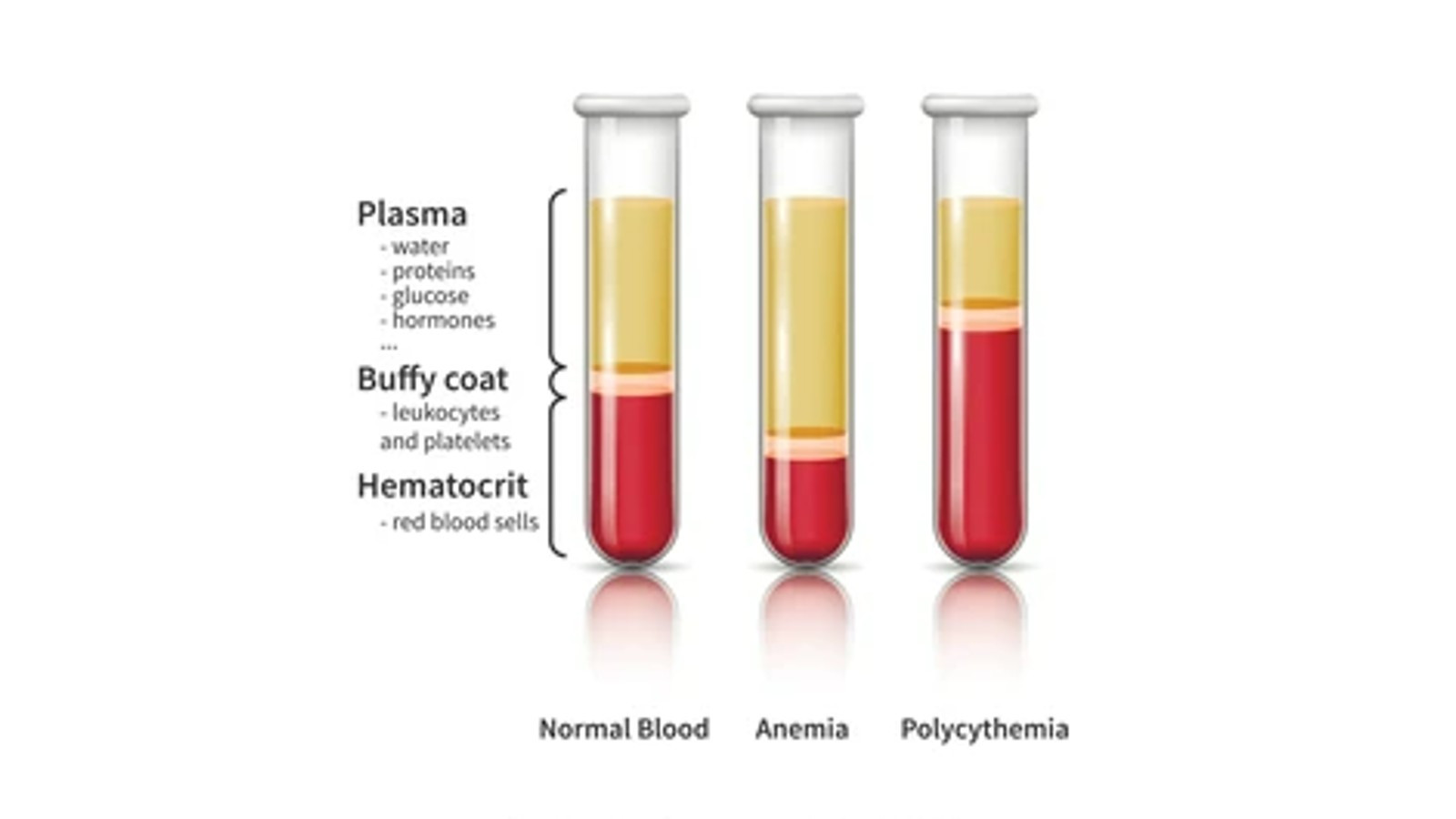Definition
Polycythemia is a medical condition in which the body produces too many red blood cells responsible for carrying oxygen from the lungs to different parts of the body. This overproduction increases blood volume and thickness, which can eventually cause resistance to blood flow.
Generally, polycythemia is divided into two categories:
- Primary Polycythemia is caused by the excess production of red blood cells due to mutations or biological factors in bone marrow
- Secondary Polycythemia is caused by factors that reduce the amount of oxygen reaching the body tissues, such as smoking, high altitudes, or congenital heart disease. Red blood cells in some patients with secondary polycythemia may contain an abnormal form of hemoglobin that does not release oxygen quickly (high-affinity hemoglobin)
There are three forms of primary polycythemia:
- Polycythemia Vera or Primary Bone Marrow Polycythemia is an adult disease of hematopoietic stem cells or precursor cells responsible for blood-producing
- Primary Familial and Congenital Polycythemia, caused by genetic disorders or inappropriate levels of a hormone called erythropoietin (which triggers red blood cell production)
- Neonatal polycythemia is a condition that is detected and usually treated in the neonatal intensive care unit either before or after birth.
The prevalence of polycythemia vera is around 22 cases per 100,000 population. It is believed to occur more frequently among patients of Eastern European Jewish descent than among other European and Asian populations. Polycythaemia vera shows a male predominance in all races and ethnicities, with a male-to-female ratio of about 2 to 1.
The average age of prevalence for patients with polycythemia vera is 60 years, rarely found before the age of 40. Polycythaemia due to hemoglobinopathies and congenital cyanotic heart disease may be detected in younger patients.
Read more: Congenital Heart Disease - Definition, Cause, Symptom, And Treatment
Causes
Polycythemia can be divided into several types depending on its underlying causes. In some cases, the underlying causes cannot be identified. However, polycythemia can be caused by the following:
- Obesity or Overweight: Excess body weight
- Smoking
- Heavy alcohol consumption
- Certain medications, including diuretics (high blood pressure medication)
- JAK2 gene mutation, a mutation in the JAK2 gene that causes the bone marrow cells to produce too many red blood cells
- Chronic Obstructive Pulmonary Disease (COPD) is a group of lung diseases that block airflow and make breathing difficult
- Obstructive Sleep Apnoea is a sleep disorder in which breathing repeatedly stops during sleep
- Kidney tumours
It is important to note that in some cases, the underlying cause of polycythemia may not be identified. If you suspect or are diagnosed with polycythemia, it is crucial to consult with a healthcare professional for a thorough evaluation and appropriate management.
Read more: Obstructive Sleep Apnea - Definition, Cause, Symptom, And Treatment
Risk factor
Several risk factors for Polycythaemia, such as:
- History of blood clots
- Age above 60 years: The risk of polycythemia increases with age, and it is more common in individuals over the age of 60
- High blood pressure
- Diabetes
- Smoking
- High cholesterol
- Pregnancy: In pregnant women, especially in the third trimester, there can be a physiological increase in blood volume. This is not pathological polycythemia and is not related to the risk factors listed above
Symptoms
These are common symptoms of Polycythaemia, such as:
- Headache
- Blurred vision
- Red skin, especially on the face, hands and feet
- Fatigue
- High blood pressure
- Dizziness
- Abdominal discomfort
- Confusion
- Bleeding or clotting disorders, like epistaxis or bruises
- Uric acid
- Itchy skin
Diagnosis
Diagnosing polycythemia requires a comprehensive process involving medical history or interview, physical examination, and diagnostic tests.
The doctor will ask the patient about their main complaints, associated symptoms, how long they have been experiencing these symptoms, any history of previous illnesses, and their family medical history. Subsequently, the doctor will conduct a physical examination, including vital sign assessments such as blood pressure, respiratory rate, pulse, and body temperature. The doctor will also examine your overall physical condition from head to toe.
Next, the doctor will perform diagnostic tests. Tests that may be conducted to diagnose polycythemia include blood tests to examine the number of red blood cells in your blood and the volume of space occupied by red blood cells (hematocrit level). A high concentration of red blood cells indicates polycythemia. Often, doctors diagnose polycythemia after conducting these diagnostic tests.
General practitioners may refer you to a hematologist (a specialist in blood disorders) for further examination, to confirm the diagnosis, and to determine the underlying cause. A hematologist might perform additional tests, including bone marrow biopsy, blood tests to look for the mutated JAK2 gene, and ultrasound imaging tests on your abdomen to check for issues with your kidneys.
Management
Treatment for polycythemia aims to prevent symptoms and complications (such as blood clotting) and to treat the underlying causes. The steps of treatment may include:
1. Venesection (blood removal):
This procedure aims to reduce the number of red blood cells in circulation. The risk of blood clotting can be diminished by reducing the excess red blood cells.
2. Medications:
- Specific medications may be prescribed to inhibit the production of red blood cells
- Administration of blood-thinning medications such as low-dose aspirin may be recommended to prevent blood clotting
3. Addressing the underlying causes:
If polycythemia is caused by other conditions, such as lung disease, heart problems, or bone marrow disorders, treatment will focus on addressing the underlying conditions
4. Symptom management:
Symptomatic therapy may be given to address symptoms such as itching, fatigue, or other related issues
The treatment choice will depend on the type of polycythaemia, the severity, and the patient's overall health. Long-term management typically involves collaboration between the patient and the healthcare team to monitor the condition, adjust treatments, and prevent further complications. It is essential to consult with a doctor to outline a treatment plan tailored to individual needs.
Complications
Polycythaemia can lead to blood clotting, and this can pose life-threatening risks. Some complications that may occur include:
- Pulmonary embolism: Blockage in the blood vessels carrying blood from the heart to the lungs
- Deep vein thrombosis (DVT): Formation of clots in the blood vessels of your legs before potentially moving to other parts of the body
Read more: Deep Vena Trombosis - Definition, Cause, Symptom, And Treatment
These complications arise from the increased blood viscosity and risk of clot formation associated with polycythemia. Individuals with polycythemia must be aware of these potential complications and seek prompt medical attention if they experience symptoms or signs of blood clotting or related issues. Early detection and management are essential in preventing severe consequences.
Polycythaemia also increases the risk of getting heart attack and stroke. Find the nearest healthcare facility if you or your family member experience symptoms of heart attack or stroke.
Prevention
There is no specific way to prevent polycythemia. However, it is advisable to maintain a healthy lifestyle by adopting healthy habits, such as:
- Eat a balanced and nutritious diet: Ensure daily nutritional intake includes a variety of balanced foods, including fruits, vegetables, proteins, and grains
- Avoid smoking: Smoking can increase the risk of various health issues, including cardiovascular problems
- Stay hydrated: Drink enough water daily to maintain body hydration
- Regular exercise: Maintain routine physical activity to support heart health and blood circulation
- Get adequate sleep: Sufficient and quality sleep is essential for body regeneration and overall health
- Manage stress: Practice stress management techniques such as meditation, yoga, or other relaxation activities
- Annual health check-ups: Regular annual health check-ups can help detect health problems early
While these steps are not explicitly aimed at preventing polycythemia, they can contribute to overall health. It's also important to consult healthcare professionals for a more in-depth health assessment and personalized advice based on individual conditions.
When to see a doctor?
Contact a doctor if you need immediate treatment, especially if you feel several symptoms of Polycythaemia. You can visit a general practitioner or an internist.
Looking for more information about other diseases? Click here!
- dr. Monica Salim
AA Pilai et al., Polycythemia. (2022). Retrieved 20 March 2023, from https://www.ncbi.nlm.nih.gov/books/NBK526081/
Health Line - Polycythemia Vera: Everything you need to know. (2022). Retrieved 20 March 2023, from https://www.healthline.com/health/polycythemia-vera#causes-and-risk-factors
Medical News Today - Polycythemia. (2019). Retrieved 20 March 2023, from https://www.medicalnewstoday.com/articles/polycythemia#summary
NHS - Polycythemia. (2022). Retrieved 20 March 2023, from https://www.nhs.uk/conditions/polycythaemia/










